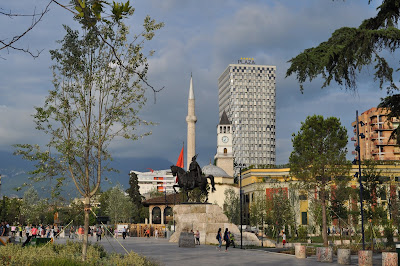Albania is a small country with amazing natural and cultural
treasures that are worth to discover. El Pais the popular Spanish daily newspaper
promotes Albania in the article titled “5 reasons to discover Albania”.
“Albania- candidate to be part of the European Union - is a
small country, with the same area as Galicia and almost three million
inhabitants, a third of whom reside in the capital, Tirana. Despite its small
size, its variety of landscapes is dazzling: mountains in the north, lakes that
penetrate neighboring countries, beaches that can compete with those of its
neighboring Greece. Lonely Planet has just included Albania in its list of top
10 destinations for 2019 for its good value for money.” writes El Pais.
 |
| View of Berat (Albania). R. HELEN GETTY IMAGES |
- In Tirana mostly, you will
see the large influence of Italian architecture at the government buildings.
The Italian influence is first on the list to visit Albania.
- The second reason is the
capital city Tirana for its mixed architecture of ottoman, Italian style,
and for the avant-garde projects as the future National Theater, a project
by Bjarke Ingels Group. The city is the main gateway to the country thanks
to the Mother Teresa airport (which was Albanian).
- The citadel of Krujë is
also one of the reasons to visit Albania. “To the north of Tirana awaits a
landscape of snow-capped mountains, ski slopes and lush forests. And
castles up impossible cliffs, as if they were eagle nests (Albania is the
country of the eagles, which wave on its flag). Its oriental bazaar leads
to a citadel which is a national symbol: from there led the resistance
against the Turks in the fifteenth century, the national hero George Castriot
Skanderbeg.”
- Apollonia was an ancient
Greek colony city and former bishopric in Illyria , located on the right
bank of the Aous river (modern-day Vjosa). After visit Apollonia you must
visit the UNESCO town of Berat.
- Llogara and Gjirokastra (The
so-called Albanian Riviera looms in the Llogara National Park. A
succession of beaches and coves, sea caves, cliffs and traditional
villages. Porto Palermo is one of the most typical pictures of this
holiday coast and Saranda, further south, is its capital. This area is
home to two of the most remarkable archaeological sites in the country:
Butrint, imitation of Troy, and Gjirokastra, with its Ottoman alleys and
roofs of stone slabs preserved in extreme because it was the homeland of the
dictator Enver Hoxha.
Read the original article here








































